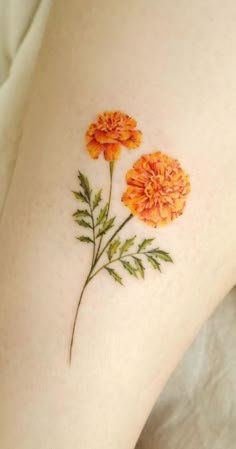Marigolds are more than just bright, cheerful blooms. Known for their vibrant colors and cultural significance, marigolds have a rich history of being used in everything from garlands to tattoos. As the artist Georgia O’Keeffe said, “Nobody sees a flower really; it is so small. We haven’t time, and to see takes time.” Let’s explore the world of marigolds and uncover their hidden beauty.
Marigolds Tattoo
Marigold tattoos carry deep symbolism and have gained popularity for their aesthetic appeal. Here’s why:






| Symbolism | Description |
|---|---|
| Meaning | Marigolds often symbolize strength, resilience, and creativity, making them a popular choice for tattoos that represent personal growth and determination. |
| Cultural Significance | In Mexican culture, marigolds are associated with the Day of the Dead, symbolizing the connection between the living and the departed. |
| Tattoo Styles | Popular styles include traditional floral designs, watercolor effects, and intricate linework, offering a wide range of artistic interpretations. |
Marigolds Flower
Marigold flowers are not only visually stunning but also have many fascinating qualities:


| Fact | Description |
|---|---|
| Botanical Name | The scientific name of marigolds is Tagetes, and they belong to the sunflower family. |
| Color Range | Marigolds come in various shades of yellow, orange, red, and even maroon, offering a vibrant display in any garden or floral arrangement. |
| Natural Pest Repellent | Marigolds are known for their ability to repel garden pests like aphids, making them a natural companion plant for gardeners. |
Marigolds Flower Aesthetic
Marigolds are frequently used for aesthetic purposes, adding a touch of brightness and warmth:

| Aesthetic Use | Description |
|---|---|
| Floral Arrangements | Marigolds are commonly used in both fresh and dried flower arrangements due to their long-lasting blooms and rich hues. |
| Festivals and Celebrations | Their bold colors make them popular in festive decor, particularly in celebrations like Diwali and Day of the Dead. |
| Symbolic Colors | The bright orange and yellow hues of marigolds are often associated with positivity, hope, and light, enhancing their use in artistic designs. |
Marigolds Drawing
Artists have long been inspired by the striking appearance of marigolds. Here’s how marigolds shine in the art world:

| Fact | Description |
|---|---|
| Artistic Style | Marigold drawings often focus on the flower’s intricate petal layers, offering artists a chance to explore detailed botanical illustration techniques. |
| Popular Techniques | Many artists use colored pencils, watercolors, or ink to capture the vibrant beauty and texture of marigold flowers. |
| Cultural Representation | Marigolds are frequently depicted in folk art, particularly in Mexican and Indian traditions, symbolizing cultural heritage and spiritual symbolism. |
Marigolds Bouquet
A marigold bouquet is a unique and eye-catching choice for various occasions:


| Fact | Description |
|---|---|
| Wedding Flowers | Marigolds are becoming an increasingly popular choice for weddings, especially in South Asian and Mexican traditions. |
| Longevity | Marigolds are known for their long-lasting blooms, making them a practical choice for bouquets that will stay fresh for days. |
| Bouquet Combinations | Marigolds pair beautifully with other flowers like daisies, sunflowers, and chrysanthemums, creating vibrant and cheerful floral arrangements. |
Marigold, Nasturtium, Azalea Flower
Marigolds are often compared with other bold, colorful flowers like nasturtiums and azaleas:



| Flower Comparison | Marigold | Nasturtium | Azalea |
|---|---|---|---|
| Color Palette | Vibrant oranges, yellows, reds, and maroons | Bright oranges, reds, yellows, and creams | Pink, white, red, and purple shades |
| Growing Conditions | Full sun, well-drained soil | Thrives in full sun to partial shade | Prefers partial shade and moist, well-drained soil |
| Cultural Significance | Widely used in festivals, especially in Mexico and India | Commonly used in salads for edible flowers | Known for being a symbol of temperance and passion in various cultures |
Marigolds Garland
Marigold garlands are a symbol of celebration, spirituality, and beauty:

| Cultural Use | Description |
|---|---|
| Religious Ceremonies | Marigold garlands are often used in Hindu and Buddhist ceremonies as offerings to deities and for adorning altars. |
| Festive Decorations | These garlands are a staple in Indian weddings and festivals like Diwali, where they symbolize purity and good fortune. |
| Day of the Dead | In Mexico, marigold garlands, known as “cempasúchil,” are used during Day of the Dead celebrations to guide spirits back to the land of the living. |
Marigold Illustration
Marigold illustrations capture the essence of these beautiful blooms:

| Fact | Description |
|---|---|
| Botanical Illustration | Detailed marigold illustrations are often used in educational materials, showing the plant’s structure and flower anatomy. |
| Decorative Art | Marigold illustrations also appear in home decor, stationery, and fashion, offering a timeless and versatile design element. |
| Historical Use | Historically, marigold illustrations were included in herbal guides and garden books, emphasizing their medicinal and ornamental properties. |
Marigolds, with their vivid colors and cultural significance, are more than just flowers. Whether you’re considering a marigold tattoo, bouquet, or adding marigold decor to your home, these versatile blooms offer endless inspiration. Share your marigold stories and ideas in the comments below—let’s celebrate this beautiful flower together!

